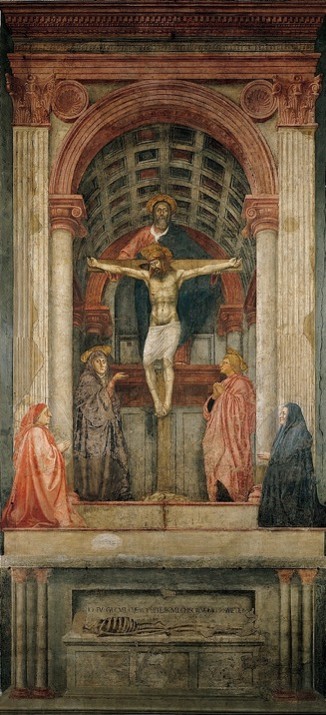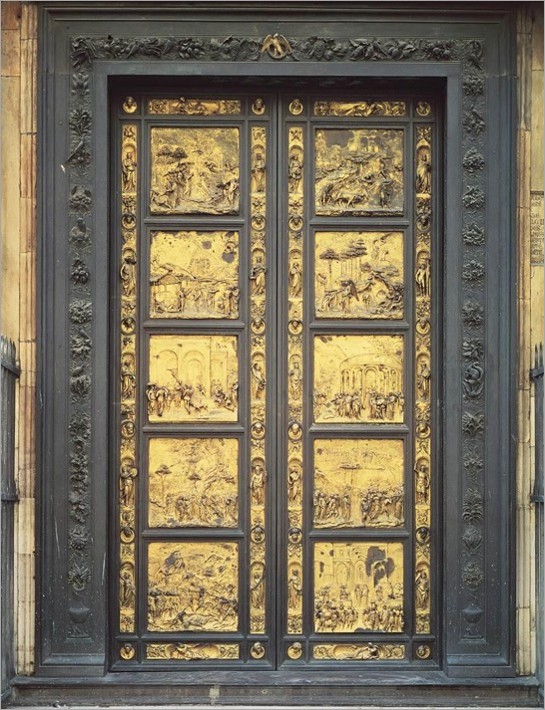土壤
一些历史背景。
- 共和制(republics)与自治城市
- 财富的累积
- 人文主义
- 新科技的涌现
佛罗伦萨之兴
竞争与个人主义(competition and individualism)=> 圣母百花大教堂(Cathedral of Saint Mary of the Flower)的穹顶:1418 年,佛罗伦萨市政府公开征集能够设计并建造穹顶的方案,精通罗马古建筑的工匠 Filippo Brunelleschi 在竞赛中胜出,受任总建筑师。
=> 骑马雕像(Equestrian)的回归:《加塔梅拉塔骑马像》(Equestrian Monument of Erasmo da Narni),多纳泰罗(Donatello),1443-53。古典主义对个人功绩的赞扬。
经验主义(empiricism)与「表征」的科学(the science of representation)=>《圣三位一体》(The Holy Trinity, with the Virgin and Saint John and donors),马萨乔(Masaccio),c. 1425-28
- 应用
单点透视(linear perspective) ,创作了一个与观者所在物理空间相通的神圣的画中空间。幻觉主义(illusionism) 作品的典范。

=>《纳税银》(The Tribute Money),布兰卡契小堂(Brancacci Chapel)湿壁画,马萨乔,c. 1425-28
- 题材取自《马太福音》:耶稣指引伯多禄(即圣彼得)从鱼嘴里取出一枚金币缴纳犹太圣殿税。
单点透视 :建筑,门徒的远近关系空气透视(atmosphere perspective) :作为背景的山脉的远近关系
=> 圣马可修道院中的湿壁画组,真福安杰利科修士(Fra Angelico),1438-45
=>《以撒的牺牲》(Sacrifice of Isaac),佛罗伦萨圣若望洗礼堂(Baptistery)的镀金铜浮雕(gilt bronze relief sculpture),洛伦佐·吉贝尔蒂(Lorenzo Ghiberti),1401-02
- 吉贝尔蒂同样也是通过竞赛赢得了设计洗礼堂第一套青铜大门的资格
- 古典主义。以撒的身体:肌肉发达,理想化,赤裸;姿态:对立平衡式 Contrapposto
=>《天堂之门》(Gates of Paradise),佛罗伦萨圣若望洗礼堂的东大门,吉贝尔蒂负责设计的第二道青铜大门,1425-52
- 10 块面板,题材取自《旧约》
- 吉贝尔蒂在门框留下了自己的头像,十分写实,体现出他的谦逊与对宗教的奉献

=>《大卫》(David),美第奇宫庭院的青铜像,多纳泰罗,1440s。
=>《维纳斯的诞生》(Birth of Venus),画布上的蛋彩画,Sandro Botticelli,c.1484-86
由古典时代开始的男女体描绘的分野:男体被视为力量,理性与英雄气概的象征,突出公共性,精神性与牺牲;女体则作为被观赏的对象,强调其感官性(sensation),柔和与母性,同欲望,神话和自然联系紧密。
意大利北部:自然与经验主义
意大利北部,如威尼斯,伦巴第等地的文艺复兴艺术:
自然的神性(the divinity of nature)=>《狂喜的圣方济各》(St. Francis in Ecstasy),Giovanni Bellini,1470s
肖像画与社会等级(portraiture and social rank):佛罗伦萨人倾向于将人物融入公共叙事(宗教或历史场景),而北方更强调个体与世俗身份。本节名录
- the Medici family (美第奇家族): a family of bankers and businessmen who ruled Florence for most of the 15th century and commissioned a lot of art
- 1435: Leon Battista Alberti (阿尔贝蒂) publishes On Painting (《论绘画》), a theoretical treatise on art
- linear perspective (or one-point perspective): a system for creating the illusion that a picture’s space is a continuation of the viewer’s space; lines perpendicular to the picture plane all recede to a vanishing point at the viewer’s eye level, and distant objects are made smaller than near objects
- atmospheric perspective (空气透视): a system for creating the illusion of real light effects based on painting the sky and landscape lighter towards the horizon and making distant objects less distinct than near objects